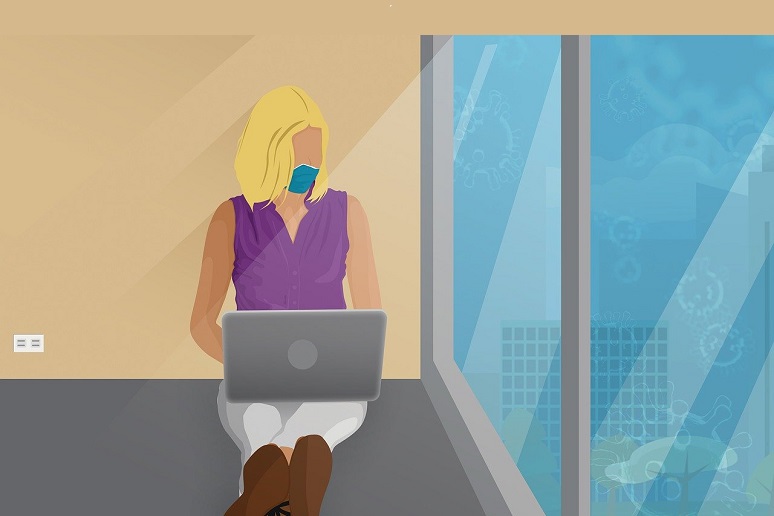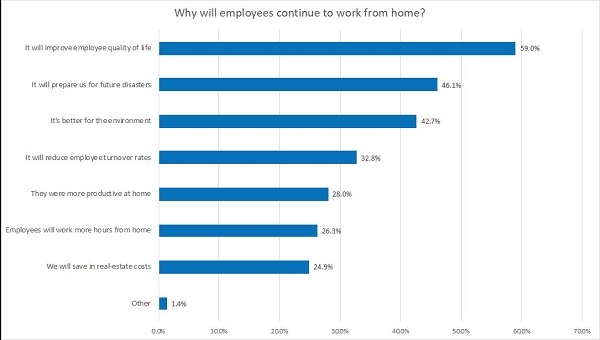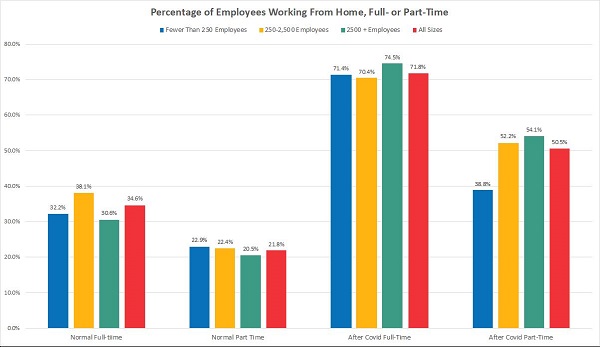A whopping 90.6% of companies say they now have employees working from home because of the virus – an increase from 63.2% before COVID-19 arrived, according to our research. Among those with contact centers, 74.1% have agents working remotely, up from 59% pre-pandemic.
Almost overnight, companies had to send dozens, hundreds, thousands, or tens of thousands of employees to home offices, depending on the size of their business. On average, they transitioned from 34.6% to 71.8% of employees working from home full-time, and from 21.8% to 50.5% of employees working from home part-time.
Those changes took place with a surprisingly low impact on the daily functions of most enterprises — a true testament to IT staffs, as well as Internet services, workplace collaboration, and contact center providers.
That’s not to say everything has been easygoing, however. Though many of the challenges that companies face are technology-related, the biggest is managing employees remotely, according to 53.5% of research participants.
Despite the many years companies have been able to support employees working remotely, work from home (WFH) isn’t right for all teams. Though meeting applications, video conferencing, and team collaboration can help smooth the situation, managers and employees used to being in the same physical location are struggling to make WFH work.
Security is the second-highest challenge, with 52.5% of organizations saying they’re concerned their remote locations may not be secure enough or that they don’t have the expertise to make them secure. Internet performance (41.2%), network infrastructure (37.8%), getting IT equipment to employees (37.1%), and access to applications (31.3%) round out the next tier of WFH challenges during the pandemic.
Interestingly, only 29.2% of IT leaders said video quality was an issue, a nod in favor of the massive number of people flooding apps such as Cisco Webex, Google Hangouts, and Zoom, among many others.
Isolating the contact center, we saw similar findings except for the top two challenges: Security was the top, with 64% of companies citing problems, followed by remote employee management at 57.1%. A small percentage, 15.3%, said they lacked analytics to measure remote agent success.
What’s Next?
But now, the real question is, what happens next? Will organizations take this experience and make changes based on the benefits they saw? Or will they toss it aside and bring things back to “normal” (whatever that might be) as quickly as possible?
The data tells us there will be a somewhat notable change to employees’ workplaces. Among the companies who just recently started to have employees WFH since COVID-19 started, only 18.9% say they won’t continue to do so post-pandemic. More than half (55.3%) say they will or probably will continue allowing employees to work from home, and 25.9% say they are unsure.
Among all companies with employees working from home now, 70.6% say they’re likely to continue doing so (35.4% are a definitive “Yes,” while 35.2% say “Probably”). Only 12.8% say they won’t continue with the WFH experiment, while 16.6% say they’re unsure. The numbers are similar in the contact center, though slightly more are definitely continuing agent WFH programs (38.5%) and fewer say probably (32.2%). Also, slightly more (14.9%) say they will not continue allowing WFH agents.
Overall, here are the top drivers for continuing a WFH strategy:
- It will improve employee quality of life (59%). Employees can reduce commute time, be home for kids when necessary, and reduce costs for dry cleaning, time spent commuting, and more.
- It will prepare companies for future disasters (46.1%). Our response to epidemics or pandemics has become forever changed because of technology. What’s more, the COVID-19 experience underscores the importance of being prepared for severe weather, natural disasters, or terrorist attacks.
- It’s better for the environment (42.7%). With fewer cars on the road and planes in the air, pollution levels have declined. For example, atmospheric levels of nitrogen dioxide air pollution declined by 30% in March 2020 compared to March 2019, according to satellite data from NASA’s Goddard Space Flight Center.
- It will reduce employee turnover rates (32.8%). If employees have a better work-life balance, they’ll be more loyal to their employer, and turnover rates will decline.
- Employees were more productive at home (28%) and will work more hours remotely (26.3%). One IT director said his company has seen a 50% increase in team collaboration messages, and employees are working two to three hours more per day. Eliminating commuting time helps, along with removing office distractions.
- It will save in real-estate costs (24.9%). Though understated in this study, we expect that companies will quickly see this value. For example, the average annual real-estate cost per contact center agent is $8,300. A 50-agent contact center would save $207,000 per year in real-estate costs by allowing half of its agents to work from home.
We expect IT and business leaders to continue their evaluation of WFH
environments and adjust accordingly. But based on their initial experiences from the pandemic, we expect to see more employees working from home, either full or part-time.












